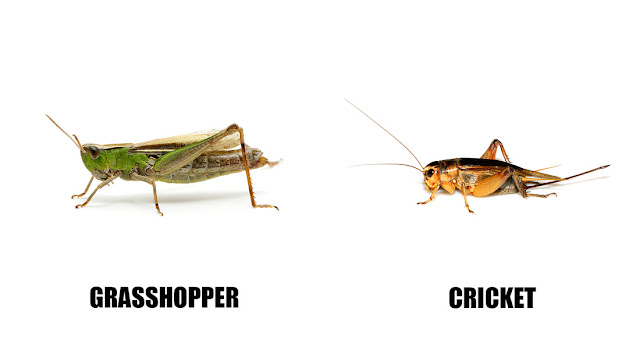Crickets vs Grasshoppers
Clearing Things Up...
I knew I'd have to do some research to learn the difference between crickets & grasshoppers, my friend & I had no real idea what it was that was making the characteristic sound of...er...one of them. Turns out that chirping sound is known as stridulation - they both do it, but it's achieved in different ways. Grasshoppers rub their long back legs against the serrated edge of their wings; they're much longer - can grow up to 4 inches, but have short antennae. Crickets stridulate by rubbing their 'sort of' wings together, and their antennae are very long. The legs & wings of the grasshopper means they can jump and fly; crickets can only jump [www.softschools.com]. Grasshoppers are green - to blend in with their habitat; crickets are pale green or brown, or dark. Thing is, all that's academic if you can't actually see them. No worries! The fact that it was afternoon when we heard whatever-it-was, meant they were grasshoppers; crickets are crepuscular - they come out at dawn & dusk. Sorted.
In the Heat of the Moment
Cricket as thermometer, otherwise known as 'Dolbear's Law'. Amazing!
The Cicada Story
 Sandie also mentioned cicadas, which she'd heard in Sydney, chirping all through the night - they make their sound at the hottest part of the day, so when the heat didn't lessen at night - they kept singing [they don't 'stridulate' like grasshoppers & crickets - they have tymbals little hollow 'drums' on either side of their abdomen which they strike making that characteristic clicking sound]. She'd seen a documentary; remembered that they spent most of their lives underground, came up to mate, but she didn't know how the eggs got back underground again. They don't. They're laid in the cracks in tree bark, then when they hatch, the larvae drop to the ground and start to burrow...Aha! So now we know!
Sandie also mentioned cicadas, which she'd heard in Sydney, chirping all through the night - they make their sound at the hottest part of the day, so when the heat didn't lessen at night - they kept singing [they don't 'stridulate' like grasshoppers & crickets - they have tymbals little hollow 'drums' on either side of their abdomen which they strike making that characteristic clicking sound]. She'd seen a documentary; remembered that they spent most of their lives underground, came up to mate, but she didn't know how the eggs got back underground again. They don't. They're laid in the cracks in tree bark, then when they hatch, the larvae drop to the ground and start to burrow...Aha! So now we know!
Other Kinds of Crickets and Grasshoppers....








Comments
Post a Comment